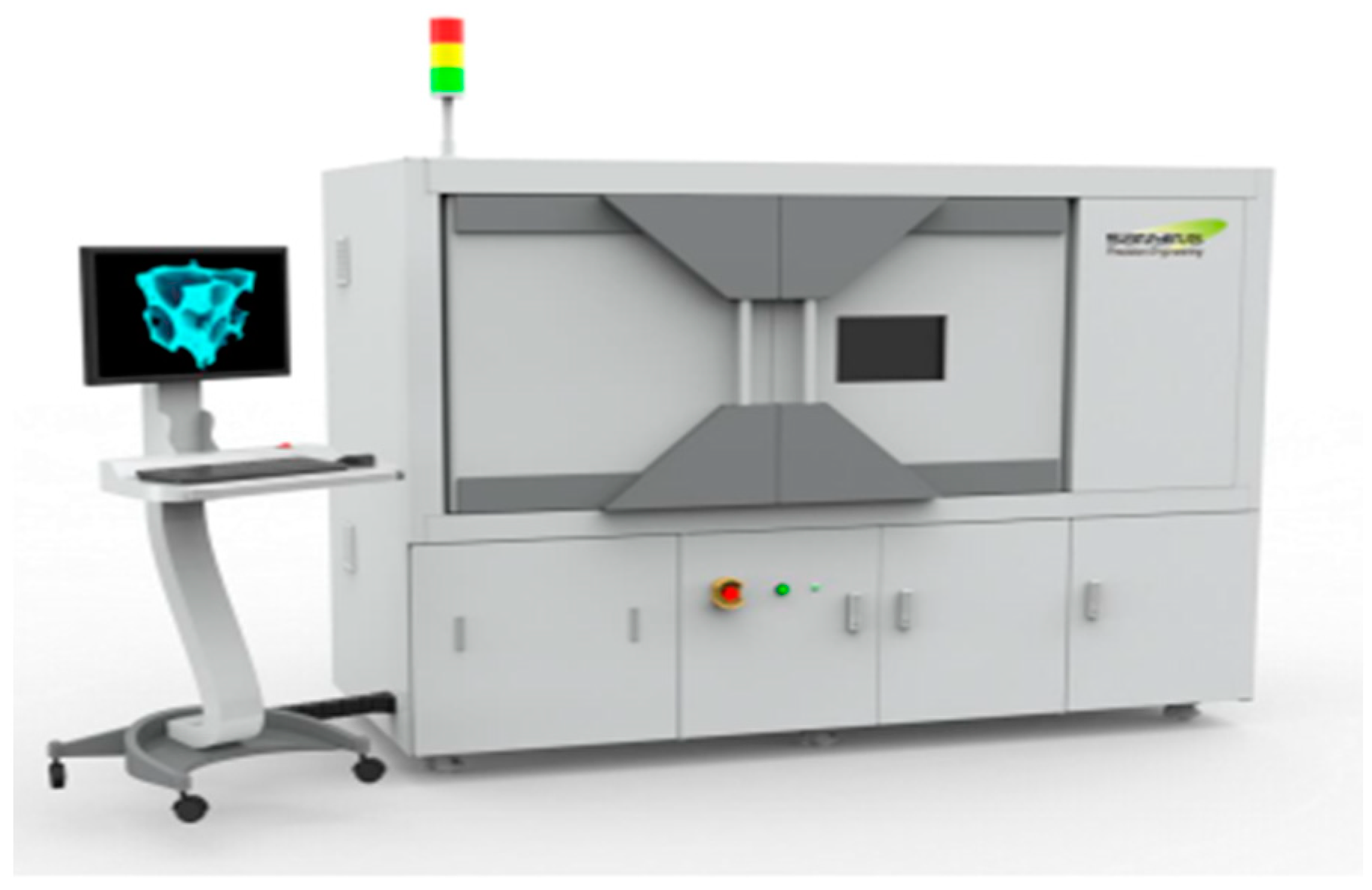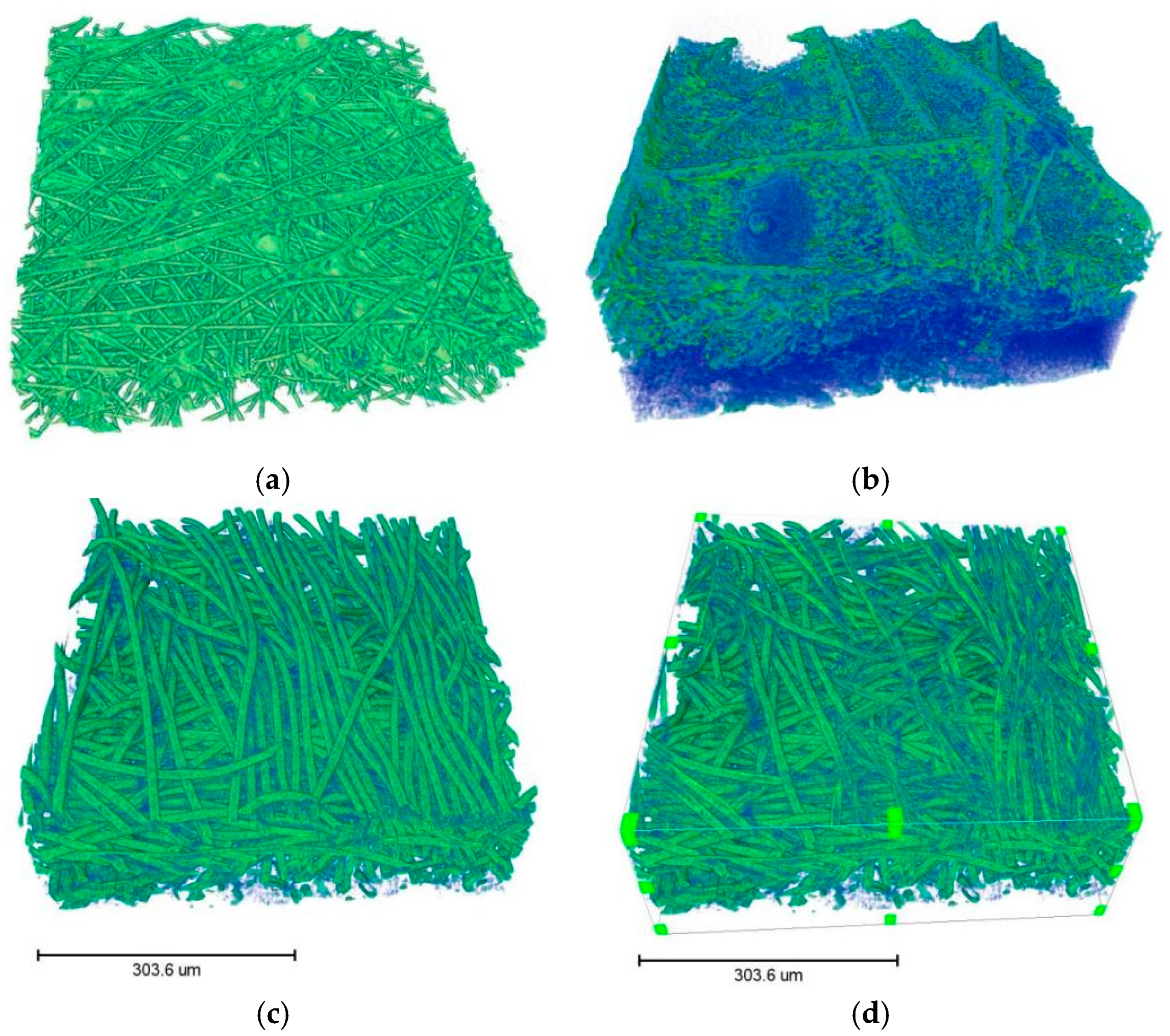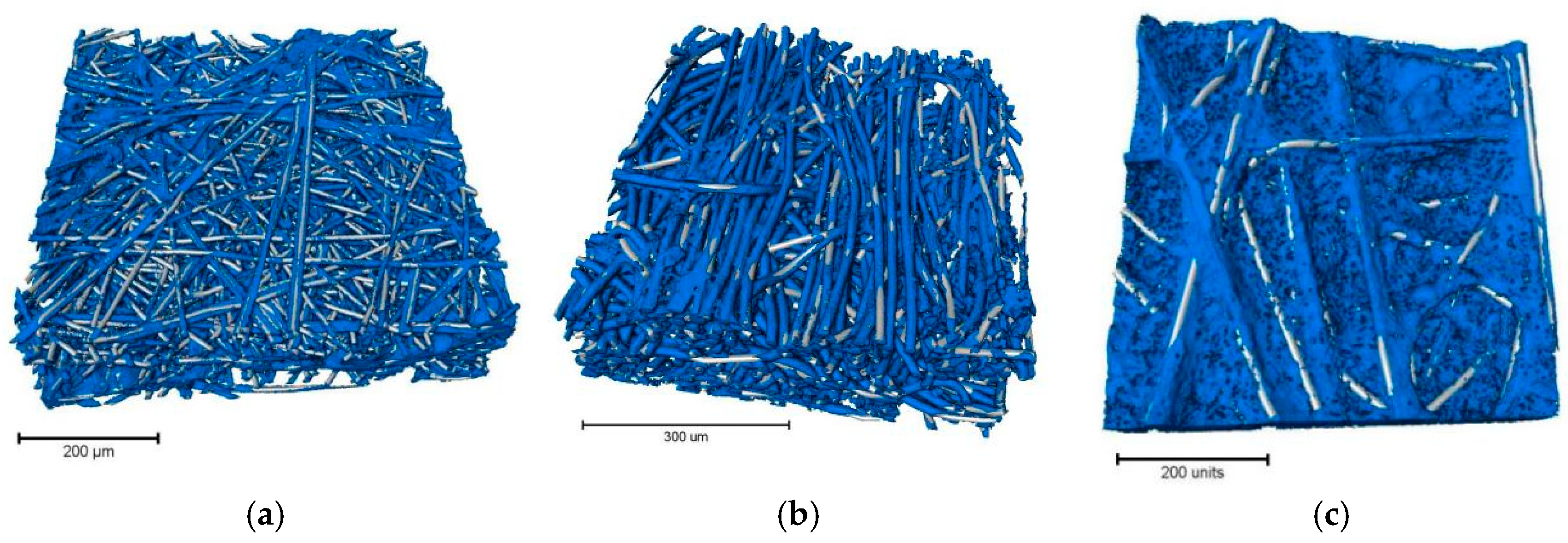Investigation of the Structural Characteristics of the Gas Diffusion Layer Using Micro-X-Ray Computed Tomography
Abstract
1. Introduction
2. Experiment
2.1. Materials
2.2. Image Processing
3. Result and Discussion
3.1. Morphology
3.2. Volume Fraction
3.3. Pore Characteristics
3.4. Bulk Characteristics
3.5. Degradation
4. Conclusions
- We have shown that 3D-μXCT can analyze the microstructure characteristics of GDLs well. Therefore, it can be used as an important method for GDL process design and failure study. The relevant experimental methods and mechanism analysis need further study.
- Mechanical compression and chemical corrosion have different effects on the microstructure of GDLs. More experiments and samples are needed to explain the degradation of GDLs under different actual conditions.
Author Contributions
Funding
Data Availability Statement
Acknowledgments
Conflicts of Interest
References
- Catumba, B.D.; Sales, M.B.; Borges, P.T.; Filho, M.N.R.; Lopes, A.A.S.; Rios, M.A.d.S.; Desai, A.S.; Bilal, M.; dos Santos, J.C.S. Sustainability and challenges in hydrogen production: An advanced bibliometric analysis. Int. J. Hydrogen Energ. 2023, 48, 7975–7992. [Google Scholar] [CrossRef]
- Olabi, A.G.; Wilberforce, T.; Abdelkareem, M.A. Fuel cell application in the automotive industry and future perspective. Energy 2021, 214, 118955. [Google Scholar] [CrossRef]
- Athanasaki, G.; Jayakumar, A.; Kannan, A.M. Gas diffusion layers for PEM fuel cells: Materials, properties and manufacturing—A review. Int. J. Hydrogen Energ. 2023, 48, 2294–2313. [Google Scholar] [CrossRef]
- Shi, Q.T.; Feng, C.; Ming, P.W.; Tang, F.; Zhang, C. Compressive stress and its impact on the gas diffusion layer: A review. Int. J. Hydrogen Energ. 2022, 47, 3994–4009. [Google Scholar] [CrossRef]
- Jiao, K.; Xuan, J.; Du, Q.; Bao, Z.; Xie, B.; Wang, B.; Zhao, Y.; Fan, L.; Wang, H.; Hou, Z.; et al. Designing the next generation of proton-exchange membrane fuel cells. Nature 2021, 595, 361–369. [Google Scholar] [CrossRef]
- Chen, Q.; Niu, Z.; Li, H.; Jiao, K.; Wang, Y. Recent progress of gas diffusion layer in proton exchange membrane fuel cell: Two-phase flow and material properties. Int. J. Hydrogen Energ. 2021, 46, 8640–8671. [Google Scholar] [CrossRef]
- Mukherjee, P.P.; Kang, Q.J.; Wang, C.Y. Pore-scale modeling of two-phase transport in polymer electrolyte fuel cellsprogress and perspective. Energy Environ. Sci. 2011, 4, 346–369. [Google Scholar] [CrossRef]
- Cecen, A.; Wargo, E.A.; Hanna, A.C.; Turner, D.M.; Kalidindi, S.R.; Kumbur, E.C. 3-D microstructure analysis of fuel cell materials: Spatial distributions of tortuosity, void size and diffusivity. J. Electrochem. Soc. 2012, 159, B299–B307. [Google Scholar] [CrossRef]
- Sizikov, V.S.; Sidorov, D.N. Generalized quadrature for solving singular integral equations of Abel type in application to infrared tomography. Appl. Numer. Math. 2016, 106, 69–79. [Google Scholar] [CrossRef][Green Version]
- Khajeh-Hosseini-Dalasm, N.; Sasabe, T.; Tokumasu, T.; Pasaogullari, U. Effects of polytetrafluoroethylene treatment and compression on gas diffusion layer microstructure using high-resolution X-ray computed tomography. J. Power Sources 2014, 266, 213–221. [Google Scholar] [CrossRef]
- Becker, J.; Fluckiger, R.; Reum, M.; Büchi, F.N.; Marone, F.; Stampanoni, M. Determination of material properties of gas diffusion layers: Experiments and simulations using phase contrast tomographic microscopy. J. Electrochem. Soc. 2009, 156, B1175–B1181. [Google Scholar] [CrossRef]
- Wargo, E.A.; Schulz, V.P.; Çeçen, A.; Kalidindi, S.; Kumbur, E. Resolving macro- and micro-porous layer interaction in polymer electrolyte fuel cells using focused ion beam and X-ray computed tomography. Electrochim. Acta 2013, 87, 201–212. [Google Scholar] [CrossRef]
- Odaya, S.; Phillips, R.K.; Sharma, Y.; Bellerive, J.; Phillion, A.; Hoorfar, M. X-ray tomographic analysis of porosity distributions in gas diffusion layers of proton exchange membrane fuel cells. Electrochim. Acta 2015, 152, 464–472. [Google Scholar] [CrossRef]
- Tötzke, C.; Gaiselmann, G.; Osenberg, M.; Bohner, J.; Arlt, T.; Markötter, H.; Hilger, A.; Wieder, F.; Kupsch, A.; Müller, B.; et al. Three-dimensional study of compressed gas diffusion layers using synchrotron X-ray imaging. J. Power Sources 2014, 253, 123–131. [Google Scholar] [CrossRef]
- Holzer, L.; Pecho, O.; Schumacher, J.; Marmet, P.; Stenzel, O.; Büchi, F.; Lamibrac, A.; Münch, B. Microstructure-property relationships in a gas diffusion layer (GDL) for Polymer Electrolyte Fuel Cells, Part I: Effect of compression and anisotropy of dry GDL. Electrochim. Acta 2017, 227, 419–434. [Google Scholar] [CrossRef]
- Atkinson, R.W.; Garsany, Y.; Gould, B.D.; Swider-Lyons, K.E.; Zenyuk, I.V. The role of compressive stress on gas diffusion media morphology and fuel cell performance. ACS Appl. Energy Mater. 2018, 1, 191–201. [Google Scholar] [CrossRef]
- Kulkarni, N.; Kok, M.D.R.; Jervis, R.; Iacoviello, F.; Meyer, Q.; Shearing, P.R.; Brett, D.J. The effect of non-uniform compression and flow-field arrangements on membrane electrode assemblies-X-ray computed tomography characterisation and effective parameter determination. J. Power Sources 2019, 426, 97–110. [Google Scholar] [CrossRef]
- Meyer, Q.; Mansor, N.; Iacoviello, F.; Cullen, P.; Jervis, R.; Finegan, D.; Tan, C.; Bailey, J.; Shearing, P.; Brett, D. Investigation of hot pressed polymer electrolyte fuel cell assemblies via x-ray computed tomography. Electrochim. Acta 2017, 242, 125–136. [Google Scholar] [CrossRef]
- Pfrang, A.; Veyret, D.; Janssen, G.J.M.; Tsotridis, G. Imaging of membrane electrode assemblies of proton exchange membrane fuel cells by X-ray computed tomography. J. Power Sources 2011, 196, 5272–5276. [Google Scholar] [CrossRef]
- Wargo, E.A.; Kotaka, T.; Tabuchi, Y.; Kumbur, E. Comparison of focused ion beam versus nano-scale X-ray computed tomography for resolving 3-D microstructures of porous fuel cell materials. J. Power Sources 2013, 241, 608–618. [Google Scholar] [CrossRef]
- Available online: https://www.thermofisher.cn/cn/zh/home/industrial/electron-microscopy/electron-microscopy-instruments-workflow-solutions/3d-visualization-analysis-software (accessed on 15 September 2023).
- Roth, J.; Eller, J.; Marone, F.; Büchi, F.N. Investigation of the representative area of the water saturation in gas diffusion layers of polymer electrolyte fuel cells. J. Phys. Chem. C 2013, 117, 25991–25999. [Google Scholar] [CrossRef]
- Toray Industries, Inc. Data Sheet. Available online: https://www.toray.com (accessed on 15 September 2023).
- Zhang, H.; Zhu, L.; Harandi, H.B.; Duan, K.; Zeis, R.; Sui, P.-C.; Chuang, P.A. Microstructure reconstruction of the gas diffusion layer and analyses of the anisotropic transport properties. Energy Convers. Manag. 2021, 241, 114293. [Google Scholar] [CrossRef]










| Connected Pores | Isolated Pores | Bulk Phase | ||||||
|---|---|---|---|---|---|---|---|---|
| Flatness | Specific Surface Area | Aspect Ratio | Average Diameter | Number | Tortuosity | Fiber Length/μm | Orientation Theta/° | |
| TGP-H-060 | 0.5296 | 0.49 | 1.491 | / | / | 1.032 | 167 | 12.7 |
| H14CX483 | 0.7001 | 0.7922 | 1.4135 | 4.08 | 174 | 1.135 | 299.5 | 18.06 |
| SGL 28BC | 0.5485 | 0.517 | 1.424 | 2.549 | 2973 | 1.012 | 227.6 | 4.06 |
| TGP-H-060-M | 0.4509 | 0.5826 | 1.705 | 5.1 | 480 | 1.027 | 149.1 | 10.7 |
| H14CX483-J | 0.6695 | 0.7869 | 1.4583 | 4.11 | 199 | 1.075 | 294.1 | 14.85 |
| SGL 28BC-A | 0.526 | 0.4689 | 1.4303 | 2.467 | 361 | 1.009 | 281.8 | 7.306 |
Disclaimer/Publisher’s Note: The statements, opinions and data contained in all publications are solely those of the individual author(s) and contributor(s) and not of MDPI and/or the editor(s). MDPI and/or the editor(s) disclaim responsibility for any injury to people or property resulting from any ideas, methods, instructions or products referred to in the content. |
© 2025 by the authors. Licensee MDPI, Basel, Switzerland. This article is an open access article distributed under the terms and conditions of the Creative Commons Attribution (CC BY) license (https://creativecommons.org/licenses/by/4.0/).
Share and Cite
Shi, Q.; Feng, C.; Li, B.; Ming, P. Investigation of the Structural Characteristics of the Gas Diffusion Layer Using Micro-X-Ray Computed Tomography. Energies 2025, 18, 381. https://doi.org/10.3390/en18020381
Shi Q, Feng C, Li B, Ming P. Investigation of the Structural Characteristics of the Gas Diffusion Layer Using Micro-X-Ray Computed Tomography. Energies. 2025; 18(2):381. https://doi.org/10.3390/en18020381
Chicago/Turabian StyleShi, Qitong, Cong Feng, Bing Li, and Pingwen Ming. 2025. "Investigation of the Structural Characteristics of the Gas Diffusion Layer Using Micro-X-Ray Computed Tomography" Energies 18, no. 2: 381. https://doi.org/10.3390/en18020381
APA StyleShi, Q., Feng, C., Li, B., & Ming, P. (2025). Investigation of the Structural Characteristics of the Gas Diffusion Layer Using Micro-X-Ray Computed Tomography. Energies, 18(2), 381. https://doi.org/10.3390/en18020381






